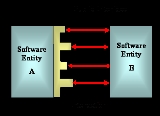
Public interface
Encyclopedia
A public interface is the logical point at which independent software entities interact. The entities may interact with each other within a single computer, across a network, or across a variety of other topologies. It is important that public interfaces be stable and designed to support future changes, enhancements, and deprecation in order for the interaction to continue.


Guidance
- A project must provide additional documents that describe plans and procedures that can be used to evaluate the project’s compliance.
- Provide an architecture design document.
- Provide a coding standards document.
- Provide a software release plan document.
- Provide a document with a plan for deprecating obsolete interfaces.
- Create fully insulated classes.
- Insulate public interfaces from compile-time dependencies.
Best practices
- Present complete and coherent sets of concepts to the user.
- Design interfaces to be statically typed.
- Minimize the interface’s dependencies on other interfaces.
- Express interfaces in terms of application-level types.
- Use assertions only to aid development and integration.
Examples
- C++ interface
-
- Use protocol classes to define public interfaces.
- The characteristics of a protocol class are:
- It neither contains nor inherits from classes that contain member data, non-virtual functions, or private (or protected) members of any kind.
- It has a non-inline virtual destructor defined with an empty implementation.
- All member functions other than the destructor, including inherited functions, are declared pure virtual and left undefined.
- Benefits
- The benefits of using protocol classes include:
- Insulating applications from the external client
- Insulating changes that are internal to the interface
- Insulating changes to the public interface from changes to the implementation of the interface
- Insulation has costs, but these tend to be outweighed by the gains in interoperability and reusability.
- Costs:
- Going through the implementation pointer
- Addition of one level of indirection per access
- Addition of the size of the implementation pointer per object to memory requirements

